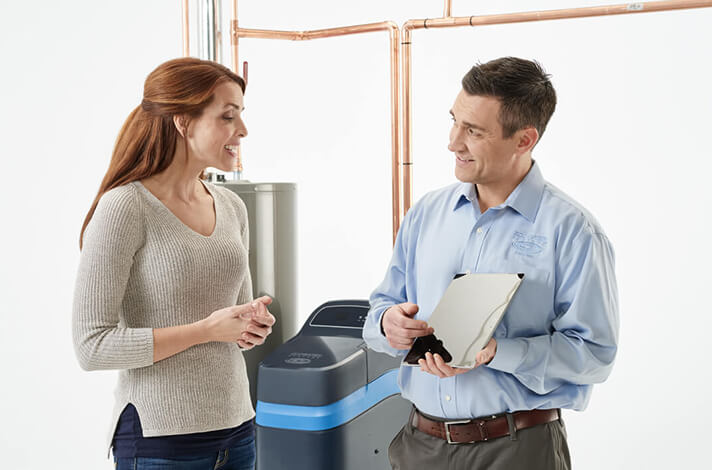While it’s true that 85 percent of areas in North America are impacted by soft water, everyone is affected by it differently. But there is good news: There are a variety of water softeners available, including salt-free solutions, to meet the needs of all homeowners.
Examine how salt-based versus salt-free water softeners work to determine which may be the better fit for your needs.

Choosing the Right Water Softener for Your Home
Whether you have municipal or well water, there’s a good chance your water is impacted by hard water minerals such as calcium and magnesium. Over time, with enough hard water minerals building up in your home’s plumbing, they may:
- Clog your pipes
- Cause scale buildup around fixtures
- Reduce your water pressure
- Damage water-using appliances, causing more frequent breakdowns
- Cause spotting on dishes and glassware
- Dry out your skin, scalp and hair
In addition to wanting to prevent the problems outlined above, there are other considerations when choosing the right water softener for solving your needs. They include:
- How hard your water is
- Eco-friendliness
- Budget
- Long-term efficiency
How Salt-Based Water Softeners Work
The majority of water softeners use salt to run an ion-exchange process which replaces calcium and magnesium ions with sodium ions. This process, using a resin bed and beads in a resin tank, reduces hard water minerals.
As resin beads inside the resin tank become increasingly saturated with the calcium and magnesium ions, they become less effective. To fix this, salt-based water softeners go through periodic regeneration cycles to recharge the ions. During regeneration, brine is flushed through the resin bed, and sodium ions replace the calcium and magnesium ions; then the displaced calcium, magnesium, and any excess brine is flushed out of the home as wastewater.
The softening process is effective in reducing hard water minerals, however salt-based softeners require regular salt replenishment and some minor upkeep to keep them working effectively. With regular care and maintenance, and depending on your water hardness, a water softener can work 10-15 years before needing replacement.
How Salt-Free Water Softeners Are Different
Salt-free water softeners, also known as water conditioners, don’t actually reduce hard water like softeners that use salt. Instead, salt-free water softeners change the chemical composition of hard water minerals to protect plumbing, pipes and water-using appliances from scale caused by hard water.
Most salt-free water softeners work via template-assisted crystallization (TAC), which requires a medium such as resin beads for creating microscopic crystals from hard water magnesium and calcium ions. The crystals don’t stick onto surfaces, creating the effect of soft water in plumbing.
The benefits salt-free softeners provide include:
- They require minimal maintenance. Conditioners need less upkeep and there’s no salt to add to your brine tank, which is helpful to seniors, individuals with disabilities and people who want little to no maintenance.
- They support an eco-friendly lifestyle. Having a water conditioner that doesn’t require salt, which is sodium chloride, helps limit the amount of salt that gets discharged from homes into waterways.
In addition to TAC, salt-free softeners can also work using electromagnetic or electronic technologies.
What Works Better for Hard Water: Salt-Based or Water Softeners With No Salt?
Picking a salt-based water softener is usually what’s best. While conditioners are helpful in a variety of ways, especially for consumers with strict sodium diets who are concerned about salt in their water, conditioners are less effective in areas with very hard or extremely hard water.
In addition to salt-based water softeners reducing water hardness minerals, they offer more benefits than salt-free options. For example, salt-based water softeners make household cleaning easier as salt-free softeners won’t provide the same sudsy, lathering effect in soaps and detergents that softened water will.
Explore water softener options with EcoWater
Learn about EcoWater’s innovative salt-based water softeners and salt-free softening options.
Get StartedOther considerations for salt-free vs. salt-based water softeners
Salt-free water softeners tend to be easier to install than models that use salt, primarily due to them not needing a drain line to flush saltwater or other waste from your home. Many salt-free solutions, especially TAC ones, don’t need to be installed near a power source. Salt-free softeners also tend to be priced more economically, making them an attractive option for those on a tight budget.
In comparison, salt-based softeners require regeneration cycles to keep working, and that requires electricity and of course more salt. Most EcoWater salt-based water softeners require on average 10 or fewer bags of salt per year.
Find the right solution
Before picking out a salt-based or salt-free water softener, learn how hard your water is. Your local EcoWater Pro can test your water for free, then provide a recommended solution that will meet your exact needs. They will also provide expert, white-glove installation.

Get Answers From an EcoWater Dealer Near You
It’s easy to find an EcoWater dealer near you who can help solve and answer any of your water problems.
